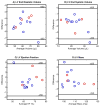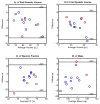Quantification of left ventricular volumes, mass, and ejection fraction using cine displacement encoding with stimulated echoes (DENSE) MRI
- PMID: 24923710
- PMCID: PMC4311752
- DOI: 10.1002/jmri.24350
Quantification of left ventricular volumes, mass, and ejection fraction using cine displacement encoding with stimulated echoes (DENSE) MRI
Abstract
Purpose: To test the hypothesis that magnitude images from cine displacement encoding with stimulated echoes (DENSE) magnetic resonance imaging (MRI) can accurately quantify left ventricular (LV) volumes, mass, and ejection fraction (EF).
Materials and methods: Thirteen mice (C57BL/6J) were imaged using a 7T ClinScan MRI. A short-axis stack of cine T2-weighted black blood (BB) images was acquired for calculation of LV volumes, mass, and EF using the gold standard sum-of-slices methodology. DENSE images were acquired during the same imaging session in three short-axis (basal, mid, apical) and two long-axis orientations. A custom surface fitting algorithm was applied to epicardial and endocardial borders from the DENSE magnitude images to calculate volumes, mass, and EF. Agreement between the DENSE-derived measures and BB-derived measures was assessed via coefficient of variation (CoV).
Results: 3D surface reconstruction was completed on the order of seconds from segmented images, and required fewer slices to be segmented. Volumes, mass, and EF from DENSE-derived surfaces matched well with BB data (CoVs ≤11%).
Conclusion: LV mass, volumes, and EF in mice can be quantified through sparse (five slices) sampling with DENSE. This consolidation significantly reduces the time required to assess both mass/volume-based measures of cardiac function and advanced cardiac mechanics.
Keywords: DENSE; heart; magnetic resonance imaging; ventricular volume and mass.
© 2013 Wiley Periodicals, Inc.
Figures




Similar articles
-
CMR reference values for left ventricular volumes, mass, and ejection fraction using computer-aided analysis: the Framingham Heart Study.J Magn Reson Imaging. 2014 Apr;39(4):895-900. doi: 10.1002/jmri.24239. Epub 2013 Oct 7. J Magn Reson Imaging. 2014. PMID: 24123369 Free PMC article.
-
Reproducibility of cine displacement encoding with stimulated echoes (DENSE) cardiovascular magnetic resonance for measuring left ventricular strains, torsion, and synchrony in mice.J Cardiovasc Magn Reson. 2013 Aug 27;15(1):71. doi: 10.1186/1532-429X-15-71. J Cardiovasc Magn Reson. 2013. PMID: 23981339 Free PMC article.
-
Myocardial 3D strain calculation by combining cine displacement encoding with stimulated echoes (DENSE) and cine strain encoding (SENC) imaging.Magn Reson Med. 2009 Jul;62(1):77-84. doi: 10.1002/mrm.21984. Magn Reson Med. 2009. PMID: 19322795 Free PMC article.
-
Efficient method for analyzing MR real-time cines: Toward accurate quantification of left ventricular function.J Magn Reson Imaging. 2015 Oct;42(4):972-80. doi: 10.1002/jmri.24869. Epub 2015 Mar 2. J Magn Reson Imaging. 2015. PMID: 25727686
-
Compressed sensing cine imaging with high spatial or high temporal resolution for analysis of left ventricular function.J Magn Reson Imaging. 2016 Aug;44(2):366-74. doi: 10.1002/jmri.25162. Epub 2016 Jan 20. J Magn Reson Imaging. 2016. PMID: 26789014
Cited by
-
Automatic segmentation of the left ventricle in cardiac MRI using local binary fitting model and dynamic programming techniques.PLoS One. 2014 Dec 11;9(12):e114760. doi: 10.1371/journal.pone.0114760. eCollection 2014. PLoS One. 2014. PMID: 25500580 Free PMC article.
-
Obesity reduces left ventricular strains, torsion, and synchrony in mouse models: a cine displacement encoding with stimulated echoes (DENSE) cardiovascular magnetic resonance study.J Cardiovasc Magn Reson. 2013 Dec 31;15(1):109. doi: 10.1186/1532-429X-15-109. J Cardiovasc Magn Reson. 2013. PMID: 24380567 Free PMC article.
-
Right Ventricular Strain, Torsion, and Dyssynchrony in Healthy Subjects Using 3D Spiral Cine DENSE Magnetic Resonance Imaging.IEEE Trans Med Imaging. 2017 May;36(5):1076-1085. doi: 10.1109/TMI.2016.2646321. Epub 2016 Dec 29. IEEE Trans Med Imaging. 2017. PMID: 28055859 Free PMC article.
-
Simplified post processing of cine DENSE cardiovascular magnetic resonance for quantification of cardiac mechanics.J Cardiovasc Magn Reson. 2014 Nov 28;16(1):94. doi: 10.1186/s12968-014-0094-9. J Cardiovasc Magn Reson. 2014. PMID: 25430079 Free PMC article.
-
Measuring Cardiac Dyssynchrony with DENSE (Displacement Encoding with Stimulated Echoes)-A Systematic Review.Rev Cardiovasc Med. 2023 Sep 18;24(9):261. doi: 10.31083/j.rcm2409261. eCollection 2023 Sep. Rev Cardiovasc Med. 2023. PMID: 39076380 Free PMC article.
References
-
- Cho GY, Marwick TH, Kim HS, Kim MK, Hong KS, Oh DJ. Global 2-dimensional strain as a new prognosticator in patients with heart failure. J Am Coll Cardiol. 2009;54(7):618–624. - PubMed
-
- Stanton T, Leano R, Marwick TH. Prediction of all-cause mortality from global longitudinal speckle strain: comparison with ejection fraction and wall motion scoring. Circ Cardiovasc Imaging. 2009;2(5):356–364. - PubMed
-
- Axel L, Dougherty L. MR imaging of motion with spatial modulation of magnetization. Radiology. 1989;171(3):841–845. - PubMed
-
- Zerhouni EA, Parish DM, Rogers WJ, Yang A, Shapiro EP. Human heart: tagging with MR imaging--a method for noninvasive assessment of myocardial motion. Radiology. 1988;169(1):59–63. - PubMed
-
- Osman NF, Sampath S, Atalar E, Prince JL. Imaging longitudinal cardiac strain on short-axis images using strain-encoded MRI. Magnetic Resonance in Medicine. 2001;46(2):324–334. - PubMed
Publication types
MeSH terms
Grants and funding
- UL1 TR000117/TR/NCATS NIH HHS/United States
- UL1RR033173/RR/NCRR NIH HHS/United States
- 5 T32 HL91812-05/HL/NHLBI NIH HHS/United States
- TL1 RR033172/RR/NCRR NIH HHS/United States
- S10 RR029541/RR/NCRR NIH HHS/United States
- UL1 RR033173/RR/NCRR NIH HHS/United States
- DP5 OD012132/OD/NIH HHS/United States
- KL2 TR000116/TR/NCATS NIH HHS/United States
- 1DP5OD012132-01/OD/NIH HHS/United States
- T32 HL091812/HL/NHLBI NIH HHS/United States
- P20 GM103527/GM/NIGMS NIH HHS/United States
- 8 P20 GM103527-05/GM/NIGMS NIH HHS/United States
- KL2 RR033171/RR/NCRR NIH HHS/United States
LinkOut - more resources
Full Text Sources
Other Literature Sources

